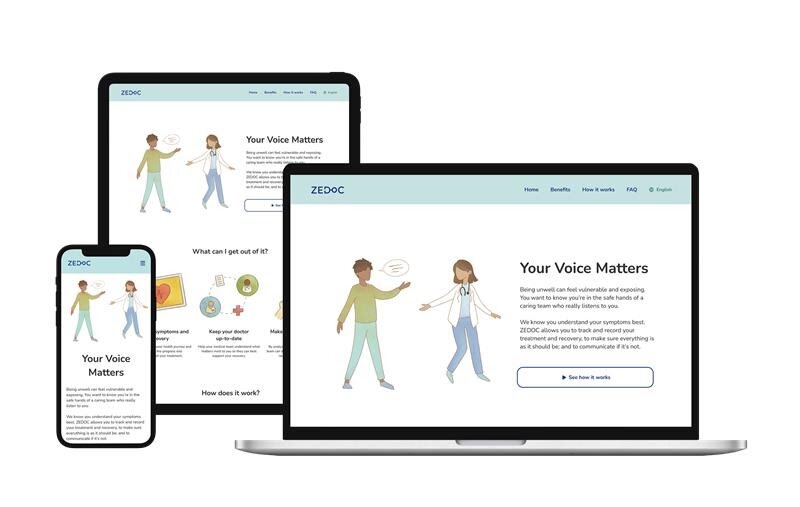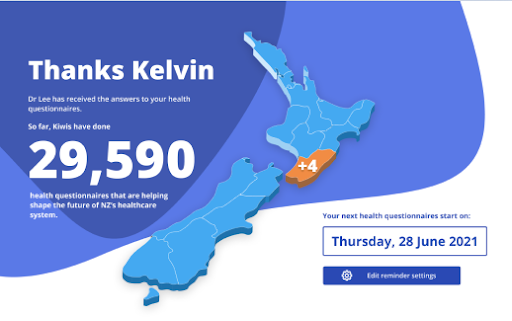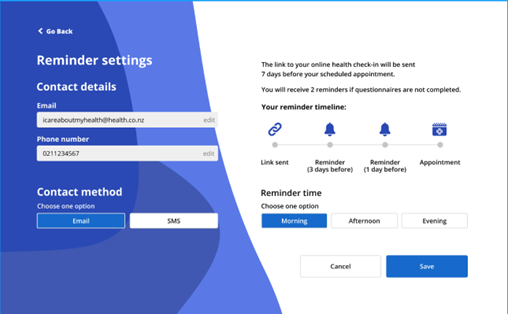Using human-centred design to solve challenges in the collection and analysis of patient-reported outcomes
A collaboration between The Clinician & Victoria University of Wellington - Master of User Experience Design.
Last December, The Clinician started a collaboration with the Master of User Experience Design (MUXD) at Victoria University of Wellington to engage Master students in a number of The Clinician’s real-world design challenges.
The Collaboration
The challenges given to the UX students focused on the experience of patients and providers in the collection and analysis of patient-reported outcomes, addressing two key areas in particular:
How to engage patients in the process of reporting their outcomes both at the start of their journey through effective onboarding and longitudinally to keep response rates high.
How to give providers using ZEDOC a seamless user experience in the process of enrolling patients, monitoring their health remotely, and using outcomes data to improve care.
Speaking about the collaboration, Jack Leggat from The Clinician explained that the idea was to give the students experience designing for real-world challenges in the digital health sector while at the same time delivering The Clinician a diverse range of solutions and high-quality insights that could be incorporated within ZEDOC to improve the user experience for patients and providers.
The Process and UX Insights Developed
The MUXD students tackled these challenges utilising diverse UX approaches and methodologies they gained in class.
Jwen Yap and her team followed the double diamond design process, which steered them to design physical, digital and in-person materials that ensured the most holistic onboarding experience for the patient.
Web Prototype & Icon Design - Jwen Yap
Brochure & Illustrations - Hannah Qiao
Content & Copy - Anna Neyland
Usability Testing - Andrew Brody-Popp & Gisela Forciniti
Based on behavioural change theories and primary research, Lucy England and her team gained understanding of patients’ motivations and engagement in self-reporting their health outcomes over time through the ZEDOC platform. Given the typically low response rates and poor patient engagement seen with digital health solutions, this research informed their designs for creating a more engaging experience for patients.
The following examples can showcase some of the implementation of their research.
We implemented these aspects into our designs by; addressing and greeting the patient on the landing page, giving them the option to personalise reminder settings, and visually displaying their contribution to the community
Lucy England - MUXD Student
Sharing their experiences working on The Clinician’s design challenges, the MUXD students described the value of designing for real-world challenges and the importance of research design and user experience in the medical field.
During class we have been learning many User Experience practices, from different research methods, to designing workshops and ideation processes. It was valuable to work through a real world problem and experience this first-hand. This has taught me how to shape the UX process to accommodate different challenges.
Alana Braddon-Parsons - MUXD Student
Embedding human-centred design approaches into the medical field required learning a lot about the patient experience and the sensitivities around health and wellbeing. Extra care needs to be taken to design solutions that ensure patients are treated as people not data.
Lucy England - MUXD Student
The more you test, the more you learn about human behaviour that you never otherwise expect
Jwen Yap - MUXD Student
Designs by Alana Braddon-Parsons, Cadence Chen, Cazz Herbert, Georgia Petrie and Nadine Paredes.
Jack Leggat, Marketing and Business Development manager at The Clinician, noted they were incredibly impressed with the work produced by the student groups, with the most valuable outcomes being the data-driven insights that they produced based on conversations with providers, patients, and extensive secondary research.
Having those UX insights and high quality prototypes will be a huge help in our product development moving forward. Perhaps more rewarding was seeing how enthusiastic the students were during the collaboration - we loved working with the groups and hope they learned some valuable lessons along the way.
Jack Leggat - The Clinician
The Importance of Human-centred Design in Healthcare
Jack notes that there are a number of unique elements in the health sector that make human-centred design so critical.
For patients, the inherent challenges of being unwell and the importance of being treated and respected as a human being make a user-centric approach to designing health technologies essential. For digital health technologies particularly, where patient engagement is so critical to their success, a special focus needs to be placed on delivering a humanistic and user-centred experience.
The importance of placing people at the centre of the design process in healthcare was echoed by the students, who reflected on their experiences designing for patients and providers:
Using human-centred design to solve problems in the health sector can result in better healthcare for the patients, and a better service being provided by clinicians. It allows us to understand and be more empathetic to the user's needs and experiences (patient or clinician). This understanding results in designing more effective solutions.
Lucy England - MUXD Student
For more information about The Clinician’s approach to collecting patient-reported outcomes and our suite of value-based digital health solutions, check out the rest of our website, our social media pages, or get in touch on info@theclinician.com.







